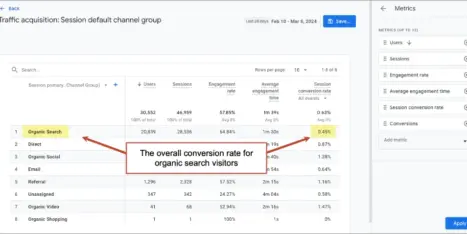Let’s start with a caveat before going any further: don’t leave your blog post for the last minute.
That’s something we all know.
Reality, of course, is different. So assuming you’re like everyone else and that you’ve pushed off writing a blog post until the day before (or day of!), it is either crunch time or panic. Either way, you have to come up with what you’re going to blog about and then write it.
There is a simple process, and it follows this general rule: Prepare beforehand, write without overthinking, clean up the mess, and package it for publishing. Done.
Work Quickly. You Can Change It Later.
If there is anything to take away from this post about writing a last-minute blog post, it’s this: stop thinking so much.
Overthinking does not work when you are pressed for time. Self-editing (at the start) does not work when you are pressed for time.
You have to work and think quickly, and that might feel a bit sloppy. Remember, you can change it later. If you don’t work quickly, there will be no later. You’ll burn through all of your available time on unnecessary details.
1. When in a pinch, turn to the topics you know best.
Unless you are lucky enough to have someone assign you a post or topic with the headline already in place, you’re going to have to start completely from scratch. Sometimes, having an assigned headline and topic makes things easier. It takes one more decision out of the equation.
Are you most comfortable writing about productivity? Then that’s going to be your go-to blog post topic because that’s what you naturally think and talk about on your own, anyway.
Where else can you find something to write about?
-
Rework the old. Think about old blog posts that you wrote that you cringe at now. Rework them and bring them up to speed with new ideas, new data, and a fresh look.
-
Quality blog feeds. Turn to your feed reader or saved research (we’ll talk about that in more detail in a bit). Lots of good ideas there.
-
Social media trends. Look at Twitter or Google+ and see what topics and hashtags are trending. Is it something you can write about? Could you get your post in on that conversation?
-
Review useful tools. Everyone loves a post that reviews apps or products. Plus, you’ll get a little traction on that app or product’s social media feed.
- Collaborate. Get contributors to write content for you by conducting an email interview. Collaborating with others makes you more productive and it’s fun.
2. Ask a question and turn them into headlines.
Ask yourself the questions others ask about your topic. Ask yourself the questions you wonder about the topic. Then, turn that into a headline.
For example, maybe you’ve wondered what are the best note apps to use while traveling, even when you have no internet connection? Why not write about it? If you are wondering, others are wondering, too.
-
The 3 Best Writing Apps For Working From The Road
-
Staying Connected To Work, Even When You Aren’t
-
How To Keep Your Content Marketing Hot While You’re On The Beach
3. Start writing and don’t look back.
When you’re frantically trying to write, self-editing is a horrible thing to do. You’ll never finish. Write as quickly as ideas come to you. Write out of order. Write down the questions you’re not sure you’re going to answer, even if only to serve as a marker for upcoming research when you get to that in the post.
Ideas, when flowing, don’t come to mind in a tidy order. It’s usually a flood. Just throw it all out there as it comes. The main goal with this phase is a kind of “free” writing. Write quickly, write badly, write excessively, just write. Clean up comes later.
Now You Can Make The Changes
This is the time for creating order out of chaos. You have the raw pieces of content, and now you’re going to assemble them and clean them up.
4. Find the start, the middle, and the end.
Look at what you wrote. Unless you are a master at logical and orderly writing, you probably have content that is out of order. This is the time to get your content into a classic outlined structure. While it may seem backwards to build the outline after you wrote the content, outlines tend to stifle writing and slowdown writing.
Think of it this way: you have to create the building blocks before you can build. This is how you will build your outline:
Intro: What’s wrong, and why they need to read.
-
Catch their attention. Start with a catchy and intriguing lede.
-
Let them know they should care or be concerned. Provide a short paragraph that presents a “problem” to the reader and indicate you have the solution.
Body: Supporting copy that points to a solution.
-
Order your supporting points logically. Do you remember geometry proofs, and how you had to logically build your case for what you were proving one step at a time? Make sure your copy naturally leads from one point to the next with no gaps in logic. e.g. you don’t drive the car before you get in it; you have to get in the car before you drive it.
-
Create clear subheadings for your points. Don’t be clever, be clear. People skim, and you’d be surprised how many read your headline, your subheadings and decide if there’s value. Your headline and subheadings alone should almost be a summary of the post.
Conclusion: Your solution reiterated, and a plan of action is clear.
-
Summarize your ideas. Wrap up your key points, and clarify the solution to the problem so the reader knows you have solved the problem.
-
Tell them what to do. People want to have something to do, especially if it’s a post that presented a problem to them. Whether it’s to sign up for an email, read more elsewhere, or a question that prompts them to respond in the comments, give your reader a chance to take action.
This breakdown of the outline structure looks complicated and anything but handy for a rushed blog post.
Don’t panic.
Free writing means writing as ideas come to you. Sometimes you get to the conclusion halfway through the post, and you start to ramble and rehash what you’ve already said down at the end. The main thing is that you have to bring order to the disorder, and it tends to go in the classic “intro, body, conclusion” format.
5. Decide what is your keyword, if that is a factor.
If you do keyword research for your blog posts, decide what the keywords will be in your post. Adjust the H2 subheadings to reflect the usage of the keywords, and make sure they are in your body copy enough so that your SEO plugins or systems give you the green light.
Do not overload your post with keywords, mind you. But if, as a habit, you create content with keywords in mind, this is where you can do the cleanup and get them in the body content and subheadings.
6. Slash, burn, and edit your copy.
Your copy is in order, you have the keywords you need in place, but you’re not done with the post yet.
Self-editing is tough, but you have to do it. In fact, according to recent blogger research, 73% of bloggers act as their own editor. So, if you have someone that can do it for you, great. Otherwise, you are going to have to remove the extraneous words, the excessive adjectives and adverbs, the quirky phrase that you repeatedly use–yes, it’s time to cut your copy mercilessly.
Looking for a few quick edits?
- You can almost always remove words like really, very, quickly, so, well, etc. We use adverbs and adjectives as we write the first time because it feels necessary. You’ll see that you can remove most of them and it does not harm the copy.
- You can always remove phrases like I think, I believe. You are the writer. Of course you think and believe what you’re writing. Those phrases serve no purpose other than to soften the blow in your mind as you write something assertive.
-
You should always remove repetition, either the same noticeable word used in consecutive sentences, or the same lines of thought in multiple paragraphs. Repetition gives the reader an uncomfortable feeling of sing-song in their head when the same word is used, or the feeling that they are wasting their time and going in circles if it’s the same ideas. Read things out loud if you must. You’ll hear the repetition right away.
-
You should make sure the tense is the same. Pick present, past, or future. Keep it the same all the way through.
The initial writing was purposefully rule-free, just to get you thinking and dumping all of your thoughts and research into the post. The editing is here to corral those wild thoughts and get them headed in the same direction.
7. Rework your headline if needed.
Chances are pretty good that your headline doesn’t match what you wrote as well as it could.
Maybe you didn’t come up with 25 reasons to use hashtags, only thinking of 15. Maybe you need to rethink it because of the keywords you decided to use. Maybe you started off writing about productivity apps and ended up writing about something completely different.
Writing in a rush can be a free-for-all, and you take what you can get as far as research and where the mind leads you. And that’s perfectly fine.
Change the headline to reflect what the post is really about. The only reason you started with a headline is to prime the pump and get you writing. There’s no reason to protect it at this point.
Writing A Great Post Starts Before You Write
Writing great content when your time is limited requires a deep well to draw from. Truthfully, writing in these kinds of “battle conditions” starts long before you do the actual writing.
Stockpile resources and content for emergencies.
Reporters and journalists often kept clippings and created files with different articles and items of interest. It was a place they could go to for research and ideas. You should be doing the same, whether your files are in a digital clipping app or old-school paper files.
In an ideal blogger’s world, you would regularly read blog feeds, books, or magazines that are relevant to what you write about on your blog.You would be saving things that are interesting and intriguing to you, content that you’ll be able to easily talk about in your writing because you’re already curious.
Input is half the battle, and writing last-minute blog posts is much easier if you’ve been reading and collecting all along. With a stockpile of research and reading, you don’t feel like you’re facing an unforgiving blank screen after all.
Almost everything is a derivative.
Why are some bloggers afraid to base their own content on what other’s have written?
They think it’s cheating. Or theft.
There is a great deal of pressure to be completely unique and original, but in a time crunch, accepting the fact that most things are a derivative and inspired by someone else’s content will keep you from getting stuck staring at a blank screen, unable to write.
You should never copy, plagiarize, or merely re-word the work of someone else, but the content that others have already written gives you so many possibilities. You can write:
-
Your reaction to a piece of content.
-
Your interpretation of a piece of content for your audience.
-
A new context to a piece of content.
-
A comparison between several pieces of content.
-
Connecting outside content to something you’d written previously.
-
Packaging up several pieces of outside content into one post.
Someone else may have written on the topic, but you have a chance to tackle it with your own opinion, experience, and data.
Again, we all know we shouldn’t wait for the last minute. We all know we should pay attention to the editorial calendar and plan ahead. But sometimes life gets in the way. If you’re blogging, you’ll end up, at some point, writing in a rush.
Be prepared beforehand, and then tackle it with this system.
What tips do you have for writing at the last minute? We’d love to hear them in the comments below.




